Bearded dragons are fascinating creatures, and there’s a whole lot to learn about them. In this blog post, we’ll do our best to provide a comprehensive guide to the different species, morphs, and colors of bearded dragons. We understand that this information can be overwhelming, especially for first-time owners, so we’ll try to break it down into easy-to-understand sections: species, morphs and then colors.
The Bearded Dragon Species
There are several species of bearded dragons (specifically eight recognized species), but the most commonly kept as pets are morphs derived from the central bearded dragon (Pogona vitticeps) and the inland bearded dragon (Pogona minor).
They are:
- Central Bearded Dragon (Pogona vitticeps)
- Eastern Bearded Dragon (Pogona barbata)
- Western Bearded Dragon (Pogona minor minor)
- Nullarbor Bearded Dragon (Pogona nullarbor)
- Rankin’s Dragon or Lawson’s Dragon (Pogona henrylawsoni)
- Small-scaled Bearded Dragon (Pogona microlepidota)
- Abrolhos Dwarf Bearded Dragon (Pogona minor minima)
- Mitchell’s Bearded Dragon (Pogona minor mitchelli)
Pogona vitticeps: The Central Bearded Dragon

The Central Bearded Dragon, also simply known as “Bearded Dragon,” is the most common species kept as pets worldwide. Native to central Australia, these Beardies thrive in woodlands, deserts, and dry shrublands.
Key Characteristics
- Triangular-shaped head
- Robust body
- Long tail, making up nearly half their total body length
- Shades of brown and gray, often with reddish accents
- Rows of spikes along the sides of the head and down the body
Size and Lifespan
Central Bearded Dragons can grow up to 24 inches long and typically live for 8 to 12 years in captivity when given proper care.
Pogona barbata: The Eastern Bearded Dragon

Often found in the eastern and southeastern regions of Australia, Eastern Bearded Dragons inhabit various habitats, such as woodlands, coastal heaths, and even urban areas. They are adapted to life in trees as well as on the ground.
Key Characteristics
- Darker coloration compared to Central Bearded Dragons
- Longer body and less distinct beard
- Banded markings along the body and tail, often with subtle greens and blues mixed in
Size and Lifespan
Eastern Bearded Dragons grow to approximately 24 inches long and have a similar lifespan to Central Bearded Dragons, around 8 to 12 years with proper care.
Pogona minor minor: The Western Bearded Dragon

The Western Bearded Dragons typically have a gray-brown color with a modest-sized justifying their name. They are native to the Western parts of Australia and are accustomed to warmer climates. They display a deft ability to change their color slightly, adjusting to their immediate environments.
Key Characteristics
- Smaller, rounder heads with shorter snouts
- Unique white facial markings distinguish them from other species
- Paler colors, often with mottled patterns of brown, tan, gray, and cream
Size and Lifespan
Western and Dwarf Bearded Dragons reach up to 18 inches in length. They are known to have a lifespan of approximately 5 to 8 years, which is slightly shorter than the larger Bearded Dragon species.
Pogona nullarbor: The Nullarbor Bearded Dragon
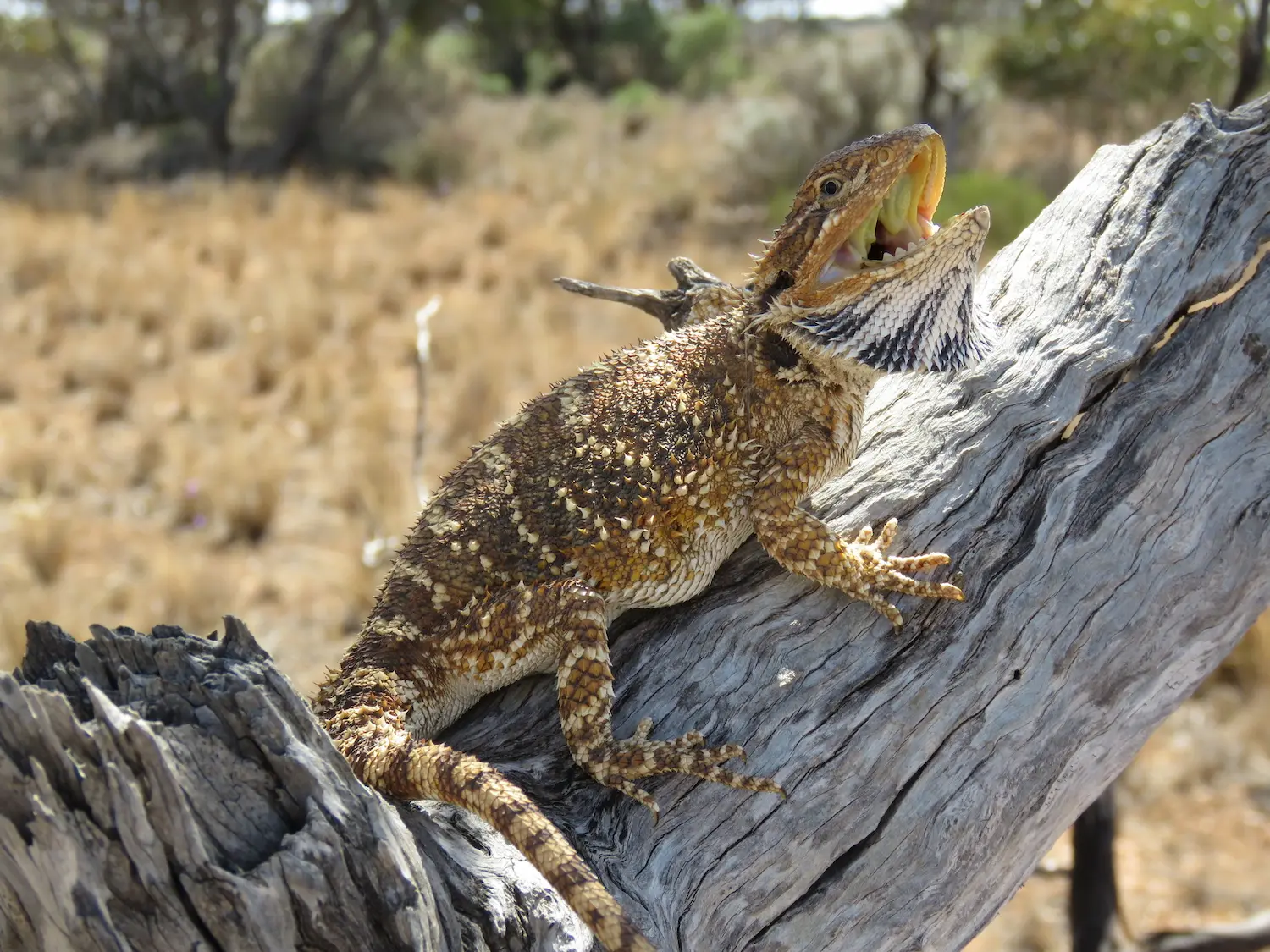
The Nullarbor Bearded Dragon is a rare and unique species, native to the Nullarbor Plain in southern Australia. Their habitat consists mainly of sandy deserts and semi-arid shrublands.
Key Characteristics
- Flat, arrow-shaped head
- Sunken eyes, an adaptation to living in harsh desert environments
- Thin beard, less pronounced than other Beardies
- Sandy or light brown coloration, which helps them blend into their surroundings
Size and Lifespan
Nullarbor Bearded Dragons are smaller, with a maximum length of around 14 inches. Their lifespan has not been well-documented due to their rarity, but it is assumed to be shorter than their larger cousins.
Pogona henrylawsoni: Rankin’s Dragon or Lawson’s Dragon
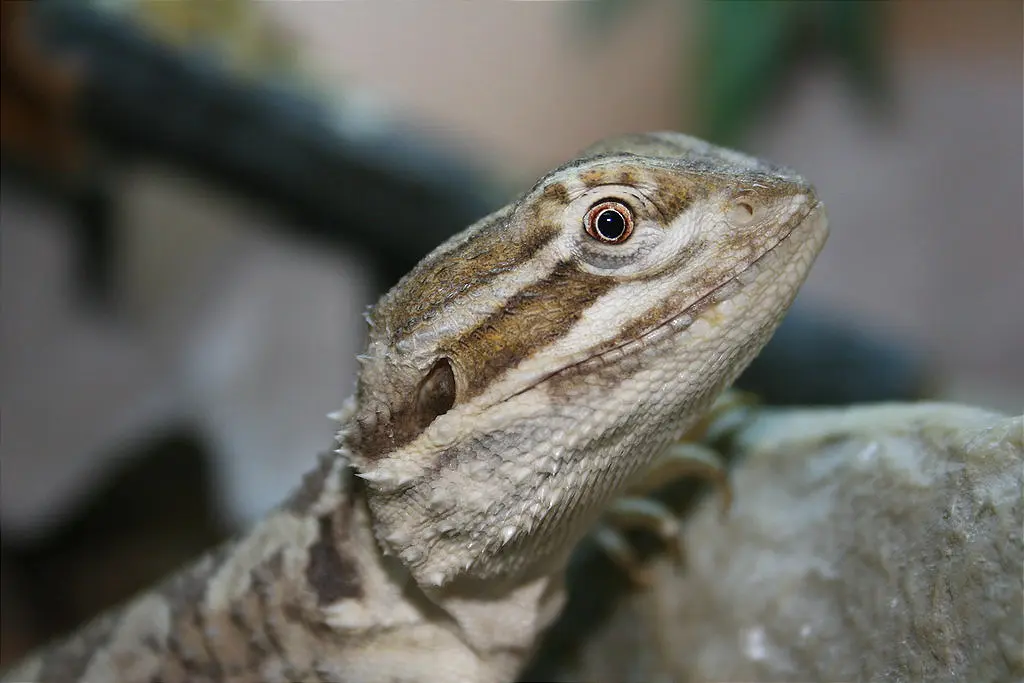
Rankin’s Dragons are characterized by their calm demeanor and smaller stature. They have a light gray-brown color which helps them hide in the arid landscapes of Queensland. Though small, they have a robust and strong body that prominently features their spiky scales.
Key Characteristics
- Rankin’s dragons are known for their docile and friendly nature, making them popular as pets. They are active during the day and enjoy basking in the sun.
- They have a flattened body shape with a spiny tail and a triangular-shaped head. Their coloration is typically tan, grey, or brown with darker markings on their back and sides.
Size and Lifespan
They usually grow between 20-30 cm which is roughly 8-12 inches, and their life expectancy is around 10 years when raised in optimal conditions.
Pogona microlepidota: Small-scaled Bearded Dragon
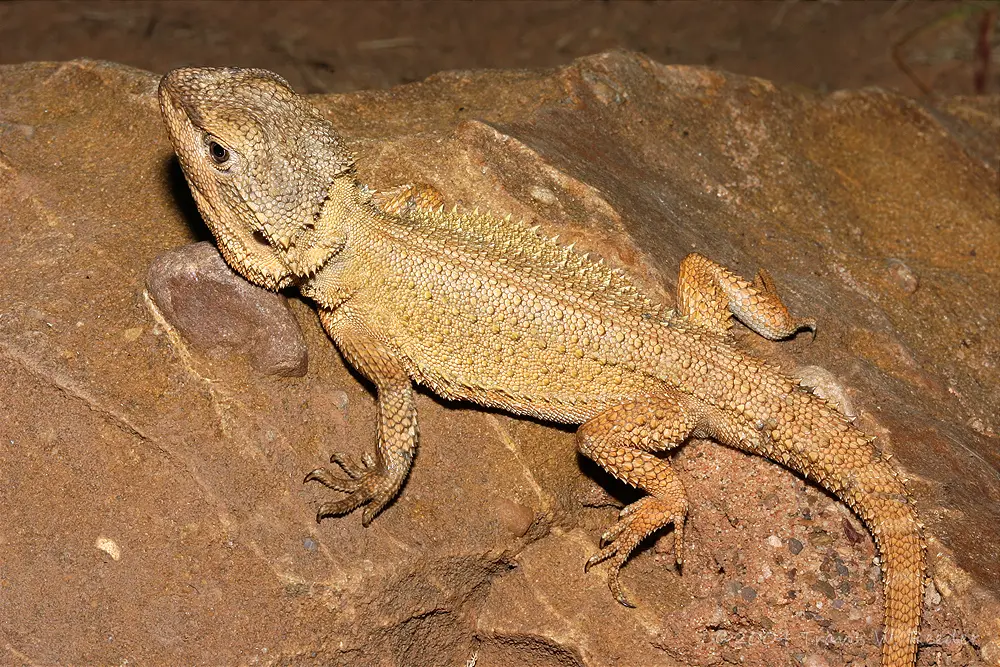
Unlike it’s bearded relatives, this particular specie is not commonly kept as a pet due to their rarity and elusive nature. Due to this, not much information is available on this specie. We however, know that they are a lot smaller than the popular vitticeps specie, coming in at around 11 inches.
Pogona minor minima: Abrolhos Dwarf Bearded Dragon

These Bearded Dragons are naturally found in the Abrolhos Islands off the western coast of Australia, hence the name. They’re smaller and their bodies are more slender compared to other species.
Key Characteristics
- This species exhibits a light to dark gray pattern, depending on the specific region they inhabit
- They are omnivorous, feeding on small insects, vegetation, and flowers.
- Abrolhos Dwarf Bearded Dragons are friendly and docile in nature, making them a popular choice as pets.
Size and Lifespan
The Abrolhos Dwarf Bearded Dragons grow up to 35 cm or roughly 14 inches. Like most Bearded Dragons, their lifespan is expected to live to around 10 years in captivity, provided they receive proper care.
Pogona minor mitchelli: Mitchell’s Bearded Dragon

Mitchell’s Bearded Dragons resemble the Western Bearded Dragon in appearance but have a slightly more slender build. Their scales can range between several shades of gray and brown, effectively camouflaging them in their diverse habitats.
Key Characteristics
- This species shares many of the common behaviors exhibited by other Pogona species. One signature activity includes arm waving, where the dragon will wave one of its front arms in a circular motion, often as a sign of submission
- Like other bearded dragons, Mitchell’s Bearded Dragon is an omnivore, feeding on a variety of insects, small vertebrates, and plant matter.
- Mitchell’s Bearded Dragon is oviparous, meaning that it lays eggs to reproduce. Females can lay up to 10 eggs per clutch, which hatch after an incubation period of around 2 months.
Size and Lifespan
They reach the adult size of about 18 inches. Found in the northern part of Western Australia, they have a distinct habitat that ranges from desert to scrubland.Their average lifespan, when given proper care and nutrition, is around 10 years.
Bearded Dragon Morphs
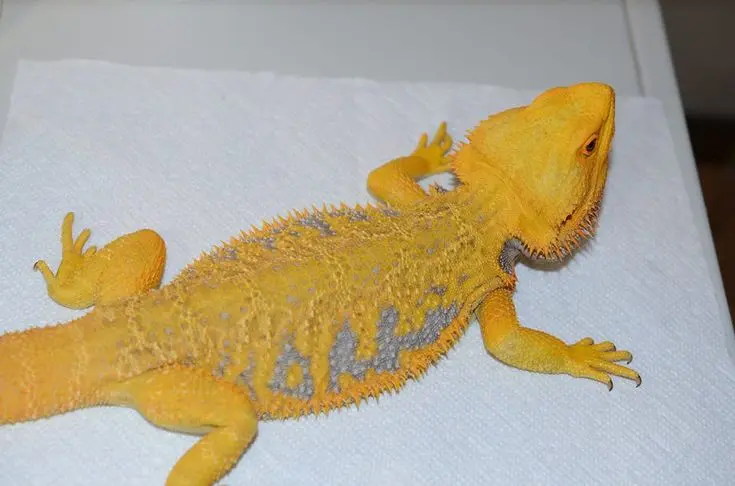
Bearded dragons are one of the most popular pet reptiles, and their popularity is in part due to the incredible range of morphs available. Bearded dragon morphs are the result of selective breeding to create individuals with unique appearances and characteristics.
From vibrant oranges and yellows to unique patterns and markings, each morph has its own distinct look and personality. In this section, we will look into the different types of bearded dragon morphs, their characteristics, and how to care for them.
So far, we have identified 13 main bearded dragon morphs. Any other variations will be updated as we find them. They are as follows:
- Classic or Standard or Wild
- Leatherback
- Silkback or Silkies
- Hypomelanistic
- Translucent
- Witblits
- Zero
- German Giant
- Paradox
- Dunner
- Wero
- Hypoleather (rare)
- Hypotrans (also rare)
Please note that while we strive to provide comprehensive information on the various types of bearded dragon morphs, the world of bearded dragon breeding is constantly evolving. New morphs are being discovered and produced all the time, and as such, this list may not be exhaustive. Regardless, we hope that this will serve as a helpful starting point for those interested in learning more about these fascinating creatures and their diverse range of morphs.
Classic/Standard/”Wild” Bearded Dragon

Standard or Classic or “Wild” (see how confusing their naming can get?) bearded dragon morphs are a mirror image of their wild counterparts in Australia. They are the closest expression of the species, both visually and genetically — largely untouched by selective breeding practices and maintaining their original earthy hues. These tones offer the dragons a natural camouflage to blend seamlessly, evading predators and hunting more efficiently.
- Characteristics: Standards prominently feature a variety of browns and tans, owing to their enclosure’s natural settings. Their scales are medium-sized, complete with rough texture – this texture is a visual and tactile characteristic that provides them the name ‘bearded dragon.’
- Behavior: Behaviors such as head bobbing, arm waving, and extended periods of basking are typically observed. These behaviors serve as communication tools among individuals. Aggression, submission, mating invitations, and dominance can all be expressed through these signature movements.
- Care Requirements: Standard care includes essential elements such as UVB lighting to synthesize Vitamin D for calcium uptake. The heating setup needs to ensure the terrarium has a temperature gradient – a cool corner for rest and a warmer basking area. Balanced diet that includes both insects and greens, an adequately sized terrarium designed to mimic their natural environment helps will help with their wellbeing.
- Lifespan: With proper care, their lifespan hovers around 10-12 years.
Leatherback Bearded Dragon
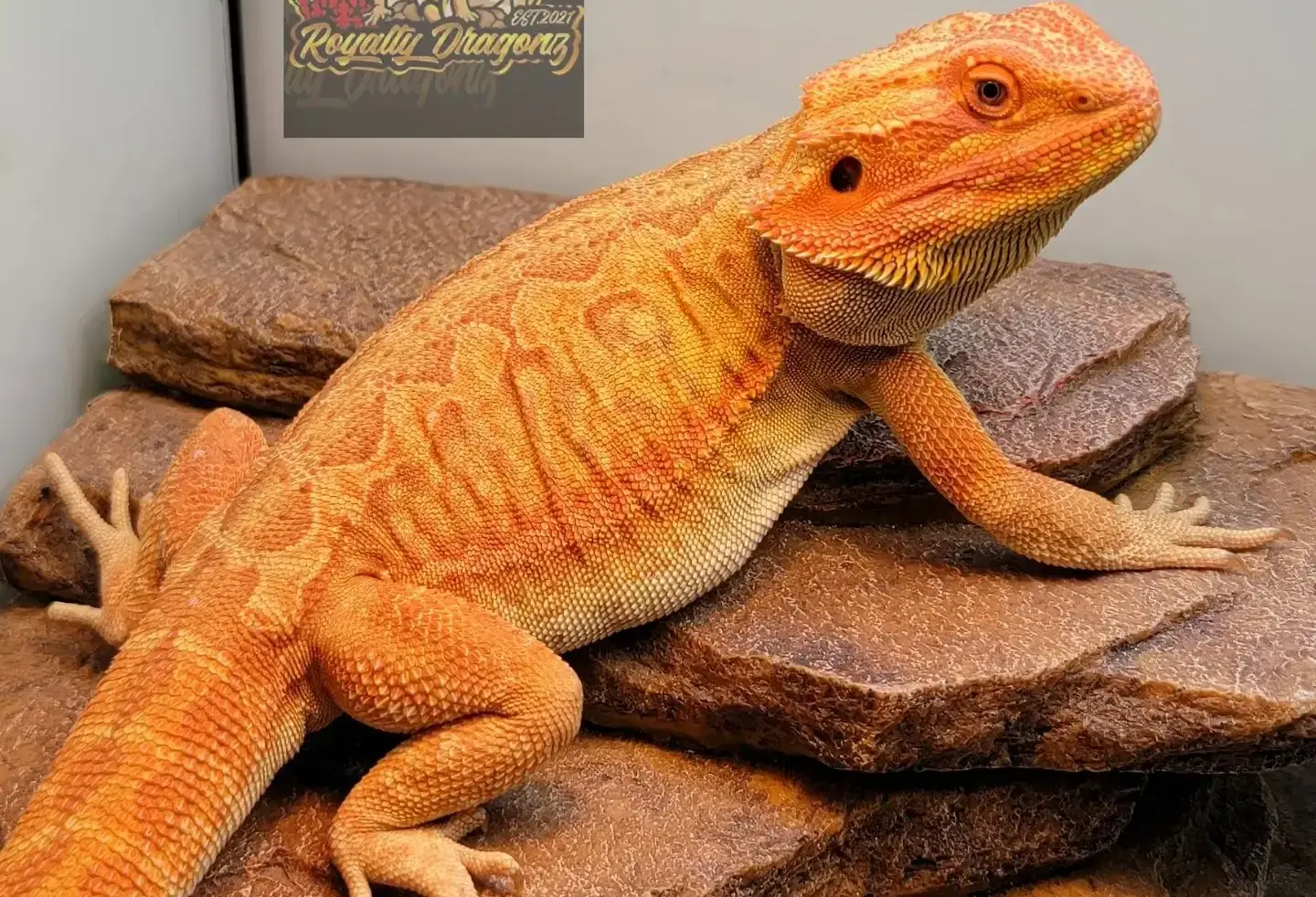
The Leatherback Bearded Dragon is a unique and fascinating morph that stands out due to its smooth and scaleless skin, giving it a distinctive leathery appearance. This feature not only gives the dragon a striking look, but also makes it easier for them to regulate their body temperature. Because of their gentle nature and captivating appearance, Leatherbacks have risen in popularity as charming and captivating pets for reptile enthusiasts.
- Characteristics: Besides their smaller scales, Leatherbacks can come in various colors—this is an effect of different genetic combinations during breeding. Their reduced scales also mean that distinctive patterns, if present, would appear much duller as compared to other morphs.
- Behavior: Leatherbacks generally exhibit the same behaviors as the Standard morph; they also partake in head bobbing, arm waving, and basking.
- Care Requirements: Leatherbacks, apart from their scale size, don’t require any special care compared to the Standard morph. They thrive under similar environments with proper UVB lighting, heat provision, and a balanced diet.
- Lifespan: These dragons can clock in a lifespan of 10 to 12 years when well cared for.
Silkback or “Silkies” Bearded Dragon

Named for the almost absent scales that give these dragons their distinguishing smoother skin, Silkbacks offer a unique twist to their Standard counterparts. This morph is the result of selective breeding, and as a result, their smooth skin can be sensitive to heat, humidity, and abrasion. Silkbacks require special care to ensure their skin remains healthy, including a more humid environment and careful handling. Despite their delicate skin, however, Silkbacks make wonderful pets and have a distinct and fascinating appearance that sets them apart from other bearded dragon morphs.
- Characteristics: Due to the absence of scales, Silkbacks carry an extraordinarily smooth, silky skin texture. Their colors range from highly vibrant to subtle, depending on the pigmentation and genetic traits passed down from their parents.
- Behavior: Silkbacks share similar behavior traits as the Standard Bearded Dragon. Activities like basking, head bobbing to convey dominance, and arm-waving to express submission are common.
- Care Requirements: They demand more attention due to their scaleless state. Their soft skin is prone to cuts and injuries, which means their habihat or enclosure needs to be free from sharp or jagged objects. Shedding can also present problems, necessitating more checks and potential moisture support.
- Lifespan: Silkbacks tend to live shorter lives compared to other morphs, usually around 8-10 years. This reduction can be attributed partially to increased care requirements and overall sensitivity.
Worthy of Note: Silkbacks, in absence of their scales, appear significantly more sensitive to their surroundings. They require gentle handling and must be protected from possible abrasions or cut risks. This is one of the ethical concerns that have been raised, objecting to the breeding of silkbacks.
Hypomelanistic Bearded Dragon

The Hypomelanistic Bearded Dragon is a morph that displays reduced melanin pigmentation compared to other bearded dragon morphs. This results in a lighter overall appearance with a more pastel or muted coloration. The eyes of a Hypo Bearded Dragon are often a brighter color than other morphs, and they may have translucent nails and a lighter underbelly.
- Characteristics: Hypomelanistic, or ‘Hypo’ bearded dragons present noticeably brighter colors.
- Behavior: Their behavior is parallel to other morphs, with their lighter appearance having no impact on their temperament.
- Care Requirements: Like their standard counterparts, Hypos thrive in identical care conditions—adequate UVB lighting, heat provision, a well-rounded diet, and an appropriately-sized habitation.
- Lifespan: Hypos usually live around 10-12 years, the standard for beardies.
Fun Fact: Hypomelanistic dragons often play a massive role in dragon breeding. They are used in combination with other morphs to achieve more vibrant offspring. For example, they are hypo-translucent dragons, hypo-zero dragons, hypo-zero-leatherback dragons, and so on.
Translucent “Trans” Bearded Dragon

The Translucent Bearded Dragon, often referred to as “Trans,” is a unique and visually striking morph that is fast gaining popularity among dragon and reptile owners alike. This morph is known for its translucent skin, making it have more visible veins and a lighter overall appearance than other morphs. The Translucent Bearded Dragon is a result of selective breeding, and while it may not be found in the wild, they are heavily sought-after due to their distinct appearance.
Characteristics
- They can have a variety of colors, including shades of yellow, orange, and brown.
- The Translucent morph can also have unique patterns and markings on their scales, making each one unique.
Care Requirements
- Like all bearded dragons, the Translucent Bearded Dragon requires a warm and dry habitat with plenty of UVB lighting.
- They need a diet that consists primarily of insects and leafy greens.
- Owners should also ensure that their enclosure has plenty of hiding spots and climbing areas.
Behavior
- Translucent Bearded Dragons have similar behavior to other bearded dragon morphs; they are generally docile and curious, making them great pets for beginners and experienced owners alike.
- These dragons may display a head bobbing behavior to assert dominance or attract a mate.
Lifespan
- With proper care, the Translucent Bearded Dragon can live up to 10-15 years in captivity.However, some dragons have been known to live longer with good care and genetics.
Witblits Bearded Dragon

The Witblits Bearded Dragon is a morph that is aptly named Witblits for its light-colored appearance, which means “white lightning” in Afrikaans. These dragons have a pale, almost white appearance with some darker markings and are highly sought after by reptile enthusiasts for their unique and striking appearance.
- Characteristics: Devoid of distinctive patterns or markings, Witblits dragons present solid, earthy colors ranging from white to beige, making them quite a sight.
- Behavior: They extend the same behavior sequences as any standard Bearded Dragon with activities such as basking, head bobbing, etc.
- Care Requirements: Just like other morphs, Witblits dragons thrive under proper heat gradient, balanced diet and adequate UVB provision.
- Lifespan: Life expectancy ranges from 10-12 years with good care.
Fun Fact: Witblits Bearded Dragons are excellent climbers and enjoy basking on rocks and other elevated surfaces.
Zero Bearded Dragon
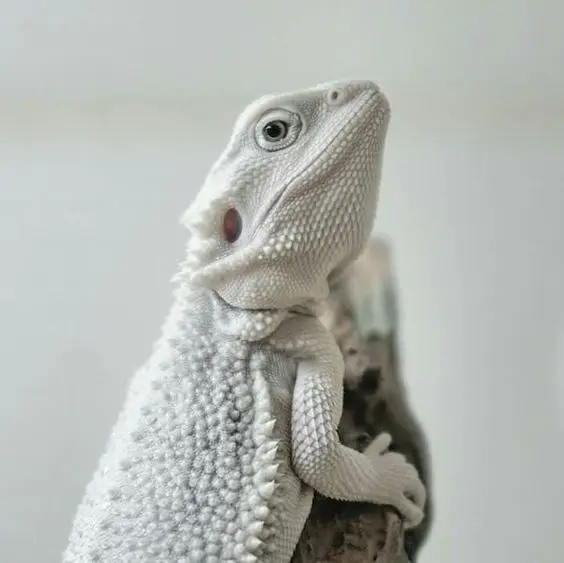
This morph is named for its lack of black pigmentation, resulting in a dragon with a very light or white appearance.
- Characteristics: Zeros, as the name suggests, flaunt a complete absence of patterns and carry an all-white or silver body. Lack of pigmentation gives them a smooth, virtually shimmering body with no markings or patterns.
- Behavior: They extend the same behavior sequences as any standard Bearded Dragon with activities such as basking, head bobbing, etc.
- Care Requirements: Their care requirements are just about the same as other morphs. They require standard UVB lighting, heat distribution, and diet.
- Lifespan: Life expectancy ranges from 10-12 years with good care.
Worthy of Note:
1. Zero Bearded Dragons can be more sensitive to light and heat than other morphs, and may require adjustments to their enclosure to ensure they are receiving the appropriate temperature and lighting levels. They also require careful handling to avoid causing skin irritation or injury due to their light pigmentation.
2. You may have noticed several color similarities between the Zero, Witblits and the Hypo dragon. This is because, while they may have some differences in their specific appearance and genetic background, they share some commonalities due to their reduced pigmentation (or lack of melanin).
German Giant Bearded Dragon

Mostly bred for their size, this morph originated in Germany…you can see where the name comes from. German Giants can grow up to 24 inches in length and weigh up to 1.5 pounds, making them significantly larger than other bearded dragon morphs.
- Characteristics: Males can reach 24 inches in length, and females can grow to 20 inches, with a larger overall body stature.
- Behavior: They extend the same behavior sequences as any standard Bearded Dragon with activities such as basking, head bobbing, etc.
- Care Requirements: They require larger terrariums and enclosures to accommodate their size, along with adequate heating and UVB lighting.
- Lifespan: Similar to Standard morphs, they live for about 10-12 years with proper care.
Worthy of Note: German Giants can make a wonderful addition to any reptile collection, but their size may make them more challenging to care for than smaller morphs.
Paradox Bearded Dragon
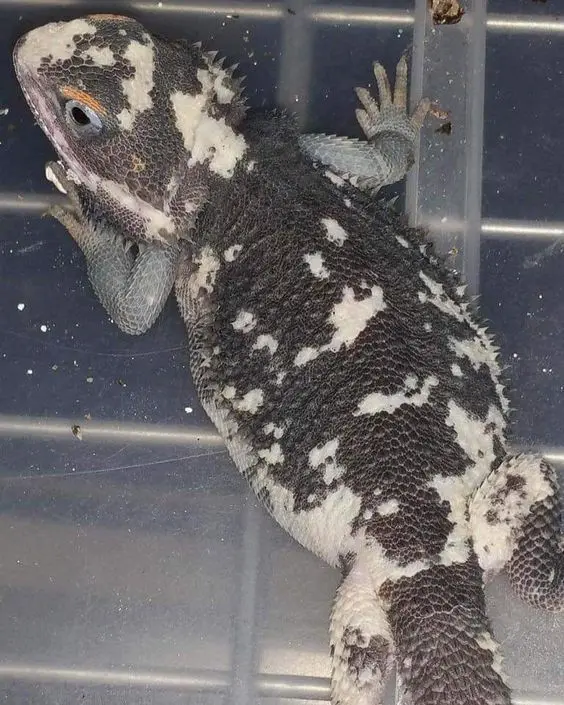
The Paradox Bearded Dragon is unlike any other. This morph is the result of a genetic mutation that causes patches of color to appear in unexpected places, resulting in a mosaic or “paradoxical” appearance. The color patches can appear on the skin, scales, and even the eyes of the dragon, creating a truly unique and fascinating appearance.
- Characteristics: Random, scattered patches of different colors and patterns than expected for their morph type.
- Behavior: Paradox Bearded Dragons are generally docile and friendly, and can make good pets for those who are willing to provide them with proper care and attention.
- Care Requirements: While the Paradox Bearded Dragon may look different from other morphs, they require the same basic care, including an appropriate enclosure with appropriate heating, lighting, and humidity levels, as well as a balanced diet that includes calcium-rich vegetables and protein sources.
- Lifespan: They are usually healthy morphs, with a typical lifespan of 10-12 years.
Fun Facts:
1. Paradox bearded dragons aren’t really considered a true morph; they’re a random genetic event that results in an irregular mix of typical and atypical colors and patterns.
2. Paradox Bearded Dragons can be more expensive than other morphs due to their rarity and unique appearance.
3. The genetic mutation that causes the Paradox Bearded Dragon’s unique appearance is not completely understood, and it is not known whether it has any negative effects on the dragon’s health over the long term.
Dunner Bearded Dragon
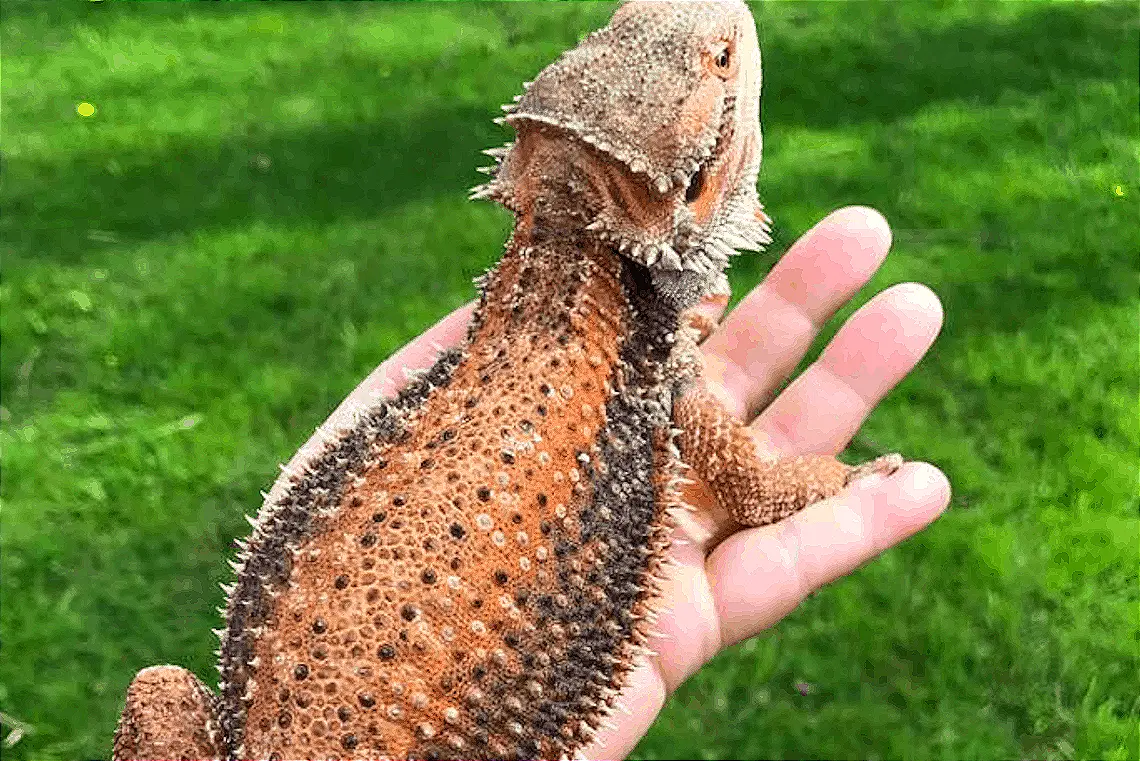

The Dunner Bearded Dragon is a morph that is named after its unique physical characteristics, which include a “dun” or stripe down the center of its back and a “dunner” pattern on its sides. This morph is highly sought after by reptile enthusiasts for its striking appearance and is the result of a genetic mutation that affects the dragon’s scales.
- Characteristics: The Dunner Bearded Dragon’s spikes or scales are unique in that they have a “dunner” pattern on their sides, which consists of a series of alternating light and dark scales that create a striping effect. This pattern is most prominent on the dragon’s sides, but it can also appear on other parts of its body.
- Behavior: Dunner Bearded Dragons are social animals and enjoy the company of other dragons, but they should be introduced to other dragons slowly and carefully to prevent aggression or injury.
- Care Requirements: Dunner Bearded Dragons require the same basic care as other bearded dragon morphs, including an appropriate enclosure with appropriate heating, lighting, and humidity levels, as well as a balanced diet that includes calcium-rich vegetables and protein sources.
- Health Concerns: While the Dunner is generally healthy, it may be more prone to certain health issues, such as respiratory infections and metabolic bone disease, due to its genetic background. Therefore, potential owners should be prepared to provide specialized care to ensure their well-being.
- Lifespan: Given optimum care, Dunners delight their keepers for a healthy 10-12 years.
Wero Bearded Dragon

The Wero Bearded Dragon is a fairly new breed of bearded dragon, developed through selective breeding efforts. The Wero is the result of crossbreeding the Zero morph with other morphs such as hypo, leatherback, and witblits. This breeding process has resulted in a unique and striking appearance for the Wero, with a distinctive white skin color, and an occassional light brown or tan coloration.
One of the most interesting aspects of the Wero Bearded Dragon is that it can be crossed with almost any other breed of bearded dragon to produce a beautiful-looking Wero. This has led to a lot of excitement and interest in the breeding community, as breeders experiment with different combinations to produce new and unique morphs.
Take for example this Dunner x Hypo x Trans x Zero crossing, resulting in this unique-looking Wero:
View this post on Instagram
When it comes to their size, Wero Bearded Dragons are typically smaller and fitting for a confined dwelling. The average length ranges from 6 to 8 inches, with a width of about 3 to 4 inches.
- Characteristics: This differs with each crossing, but expect a generally white appearance, with gray, yellow and tan bursts in between (again, dependant on what morph crossings are at play here)
- Behavior: What sets Wero Bearded Dragons apart is their notable curiosity. They are inquisitive creatures, often seen exploring their surroundings, a trait that can surely bring about an element of engagement for their keepers.
- Care Requirements: Just like other morphs, Weros thrive when given the appropriate UVB light, diet, and heating arrangements.
- Lifespan: Just like other Bearded Dragon types, Weros, with good care, can live anywhere from 10 to 12 years.
Hypoleather Bearded Dragon (rare)

A very rare morph, mostly selectively bred by expert breeders, it combines the two traits produced by the Leatherback and the Hypomelanistic — inheriting the skin texture of a Leatherback and the pale-ish coloring of a Hypomelanistic dragon. Together, these elements create an aesthetic charm, contributing to the Hypoleather Bearded Dragon’s rare desirability.
- Behavior: Hypoleather Bearded Dragons demonstrate standard behavior typical to all Dragons. They indulge in typical sequences such as head bobbing, arm waving, and basking to express their mood, assert dominance or indicate a desire for social interaction. Hypoleathers are also known to be active, inquisitive, and fairly easy to handle, resonating with the overall Bearded Dragon demeanor.
- Lifespan: As for the lifespan, Hypoleather Bearded Dragons live anywhere from 10 to 12 years, comparable to other Dragons’ lifespans.
Hypotrans Bearded Dragon (also rare)

The Hypotrans Bearded Dragon is a fascinating morph that combines the traits of Hypomelanistic and Translucent Bearded Dragons.
Characteristics
Hypomelanistic Traits: Hypotrans Dragons inherit the Hypomelanistic dragon’s lighter, pastel shades due to reduced melanin production. The body grows paler with age due to the fewer pigments responsible for dark coloration in hair, skin, and eyes.
Translucent Traits: Hypotrans Bearded Dragons exhibit lighter scales, nails, and eyes due to translucency. Their skin appears translucent, with underlying veins often visible.
- Behavior: Hypoleather Bearded Dragons demonstrate standard behavior typical to all Dragons. They indulge in typical sequences such as head bobbing, arm waving, and basking to express their mood, assert dominance or indicate a desire for social interaction. Hypoleathers are also known to be active, inquisitive, and fairly easy to handle, resonating with the overall Bearded Dragon demeanor.
- Lifespan: Their lifespan aligns with general Bearded Dragons, spanning anywhere between 10 to 12 years with proper care. This includes a well-rounded diet, exposure to UVB light, and an apt temperature gradient within their habitat.
Bearded Dragon Colors
Now, the final part of their categorization: their colors. One of the most striking aspects of bearded dragons is their wide range of colors and patterns — from bright oranges and yellows to deep greens, bearded dragons come in a variety of colors that can make them stand out and catch the eye. Let us explore the many different colors and patterns of bearded dragons, as well as the genetics behind their appearance.
Today, we’ll be talking about nine bearded dragon colors:
- Brown
- Tan
- Orange
- Red
- Yellow
- White
- Purple
- Gray
- Olive-Green
- Tiger
- Black
Brown Bearded Dragons
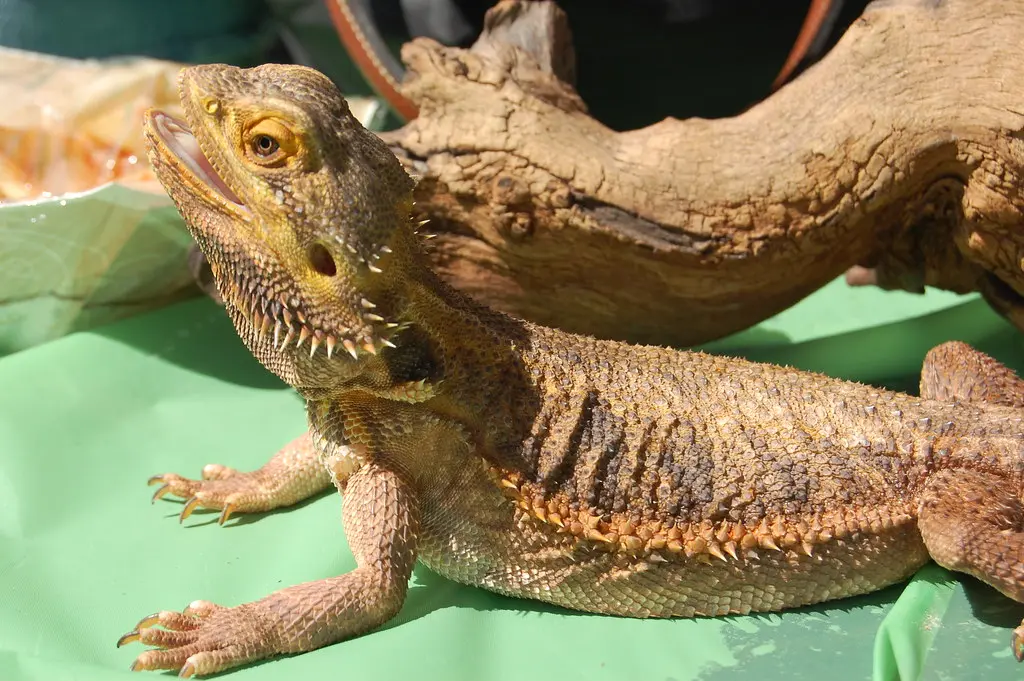
Traditionally, Bearded Dragons in the wild possess a natural earthy brown shade. This coloration camouflages them against predators and aligns with their natural environment. Varying from light to dark brown, this standard color can sometimes shift to a grayer tone.
Tan Bearded Dragons
Tan Bearded Dragons carry hues akin to light brown or sandy tones. Like their brown counterparts, it assists them blend with the arid desert landscapes, offering essential protective camouflage.
Orange Bearded Dragons

Orange Bearded Dragons, varying from bright to pastel orange hues, emerge as a result of selective breeding. Their vibrant tones add aesthetic appeal and make them favorites among enthusiasts.
Red Bearded Dragons
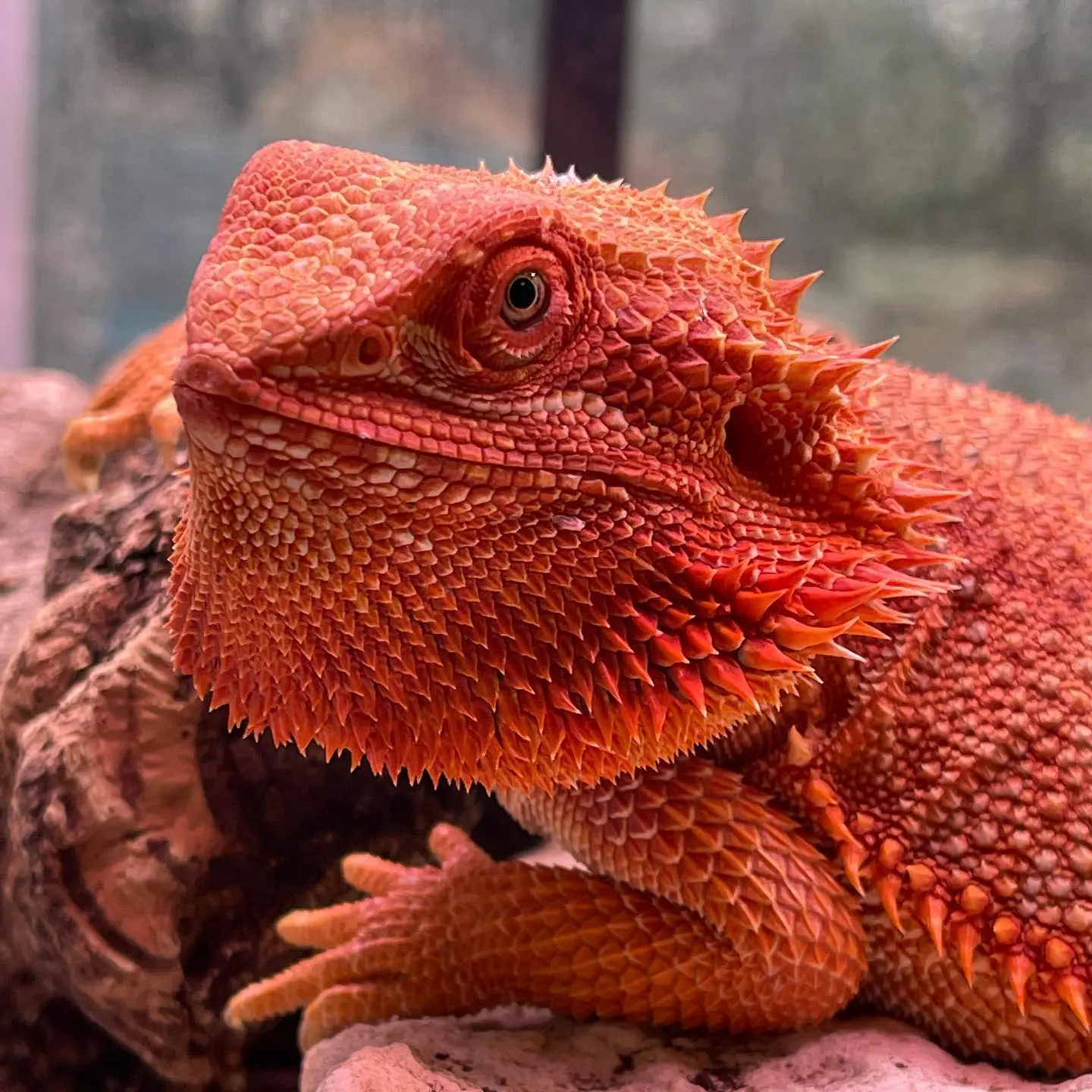
Red Bearded Dragons bring forth a spectrum of shades from deep brick red to softer pinkish hues. Recognized as Red Morphs, these variants owe their cherry pigments to the selective breeding process.
Yellow “Sandfire” Bearded Dragons
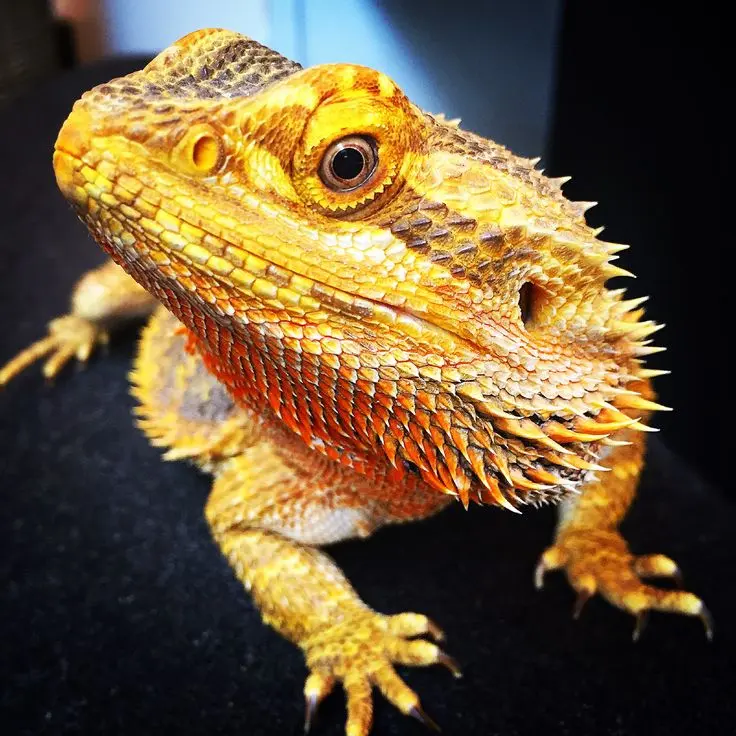
Also known as Sandfire or Citrus or Yellow Bearded Dragons, this color variant exudes shades from bright sunshine to pastel yellows. Their sunny color, a result of selective breeding, adds a vibrant touch to their overall look.
White Bearded Dragons

The White or Leucistic Bearded Dragons, owing to their Hypomelanistic traits, present a stunning pale white to ivory hue. Their color results from reduced melanin, which is a sharp contrast from their darker counterparts.
Purple/Blue Bearded Dragons

As you can expect, this bearded dragon is super rare and expensive, owing to the fact that they do not retain these colours into adult hood. So, finding one is as you can expect…super hard..pretty cure color variation though. 🙁
Gray Bearded Dragons
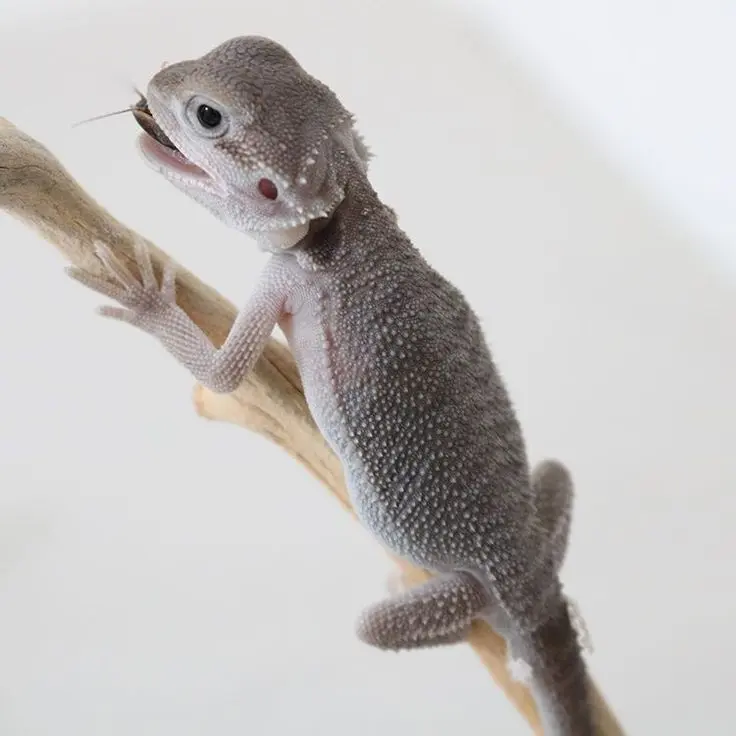
Wild Bearded Dragons often also portray a tone of light to dark gray. This coloration, akin to the browns and tans, aids in their camouflage against predators.
Olive-Green Bearded Dragons
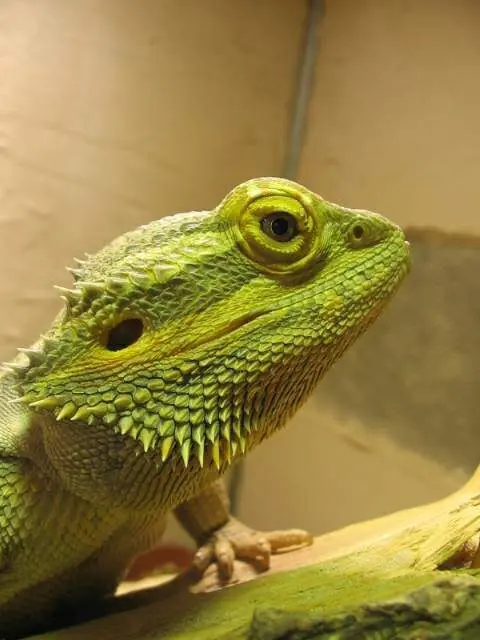
The Olive-Green Bearded Dragons can range from pale green to olive hues, which aids camouflage against predators in their native habitats.
Tiger Bearded Dragons
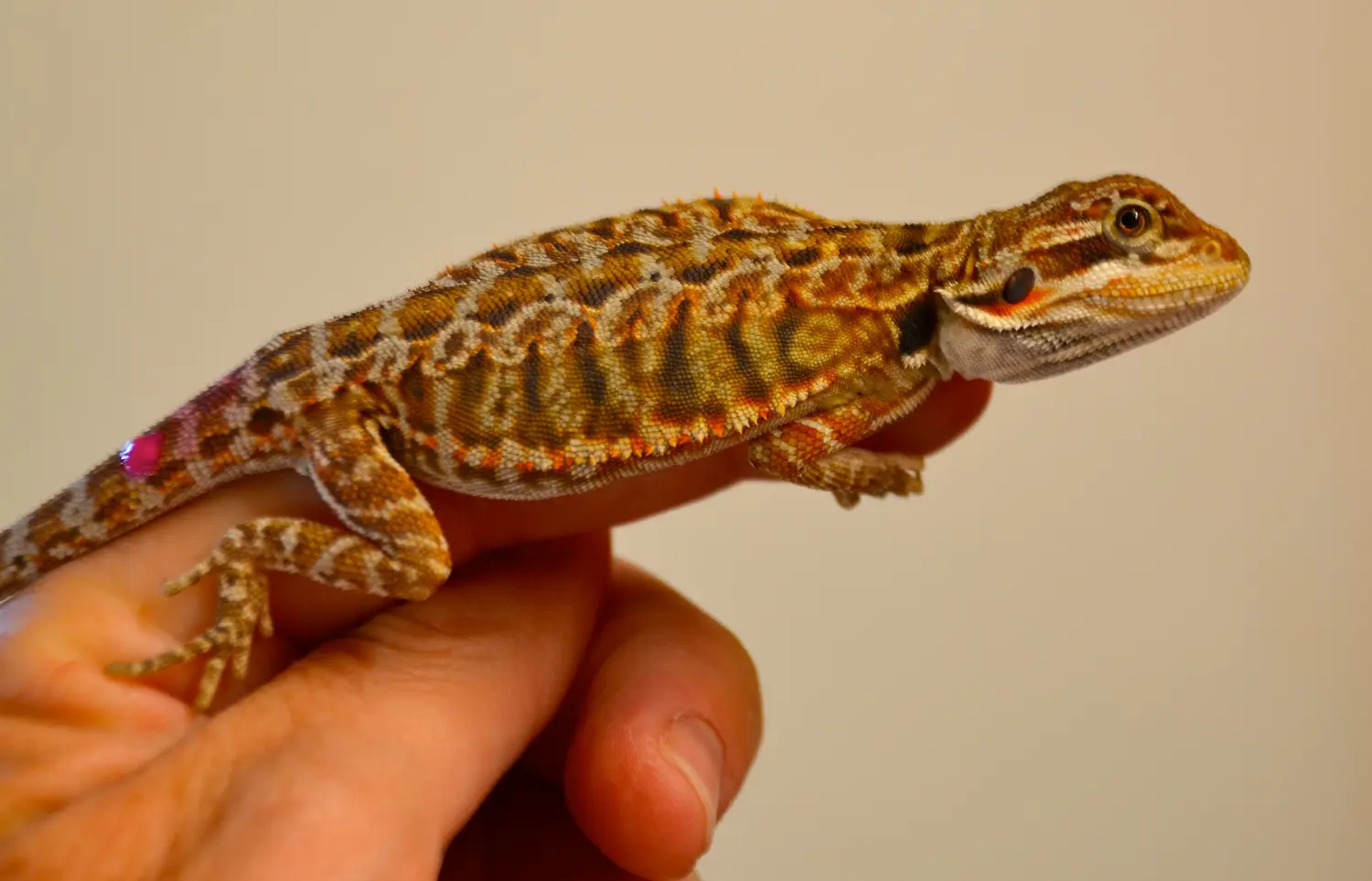
The Tiger Bearded Dragons, characterized by striped patterns on an array of colors like brown, yellow, or red, mimic tiger stripes and make for an exciting color variant.
Black Bearded Dragons

While not entirely black, Bearded Dragons can display a dark coloration that could be described as black or very dark brown. This coloration usually denotes the bearded dragon’s status or mood, such as feeling threatened or during basking or during shedding. They end up fading away at some point.
Caring For Your Bearded Dragon
Now that we have explored the species, morphs, and colors of bearded dragons, let us learn about how to care for them.
Housing
Proper housing ensures your Bearded Dragon’s comfort and happiness. Here are essential factors to consider when setting up their home:
Enclosure
- Optimal Size: A minimum of a 40-gallon tank is recommended for juvenile Bearded Dragons, while a 75-gallon tank is preferable for adult dragons.
- Ventilation: Ensure the enclosure has proper ventilation to maintain a healthy environment.
- Substrate: Opt for a safe substrate like a reptile carpet, newspaper, or tile. Avoid using loose substrates, such as sand, which can cause impaction if ingested.
Lighting and Temperature
- UVB Light: Bearded Dragons require UVB light for proper bone development and overall health. It’s crucial to provide a UVB light source and replace the bulb every 6-12 months.
- Heat Lamp: Bearded Dragons are cold-blooded; hence, they need a heat lamp to maintain their body temperature.
- Thermoregulation: They should have a basking area with a temperature between 95-110°F and a cooler end in the range of 75-85°F.
Diet and Nutrition
A balanced diet is vital for your Bearded Dragon’s well-being. Here’s what to include in their meals:
Baby and Juvenile Bearded Dragons
- Protein: Provide 70% insects (such as crickets, dubia roaches, and phoenix worms) and 30% vegetables in their diet.
- Calcium: Dust insects with calcium powder to ensure proper bone development.
Adult Bearded Dragons
- Vegetables: Adults require a higher vegetable intake, around 80%, including collard greens, mustard greens, and squash.
- Protein: 20% protein sources like insects, dusted with calcium and multivitamin powder.
- Feeding Schedule: Feed adults once a day and juveniles three times a day.
Handling and Socialization
- Gentle Handling: Handle Bearded Dragons gently and avoid grabbing them from above, as it can make them feel threatened.
- Socialization: Regular interaction helps them become accustomed to human contact.
- Sanitation: Always wash your hands before and after handling your Bearded Dragon to prevent the spread of bacteria.
Health Check-ups
- Veterinary Care: Annual check-ups with a reptile veterinarian are important to maintain good health.
- Monitoring: Keep an eye on your Bearded Dragon’s behavior and appearance for any signs of illness.
Conclusion
We’ve explored the world of Bearded Dragons and their colors and patterns, which are important for their survival and genetics. We’ve also learned how to take care of them properly, including their housing and diet.
Whether you’re a new owner or an experienced enthusiast, our guide aims to help you appreciate these unique lizards and take care of them. We hope this guide helps you deepen your bond with your pet and discover more about them.
There’s always more to learn about Bearded Dragons!
